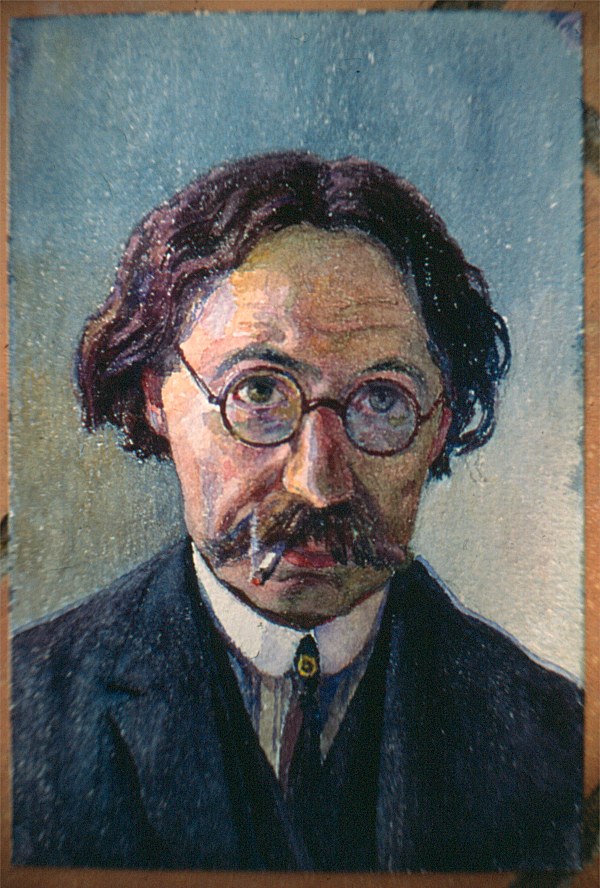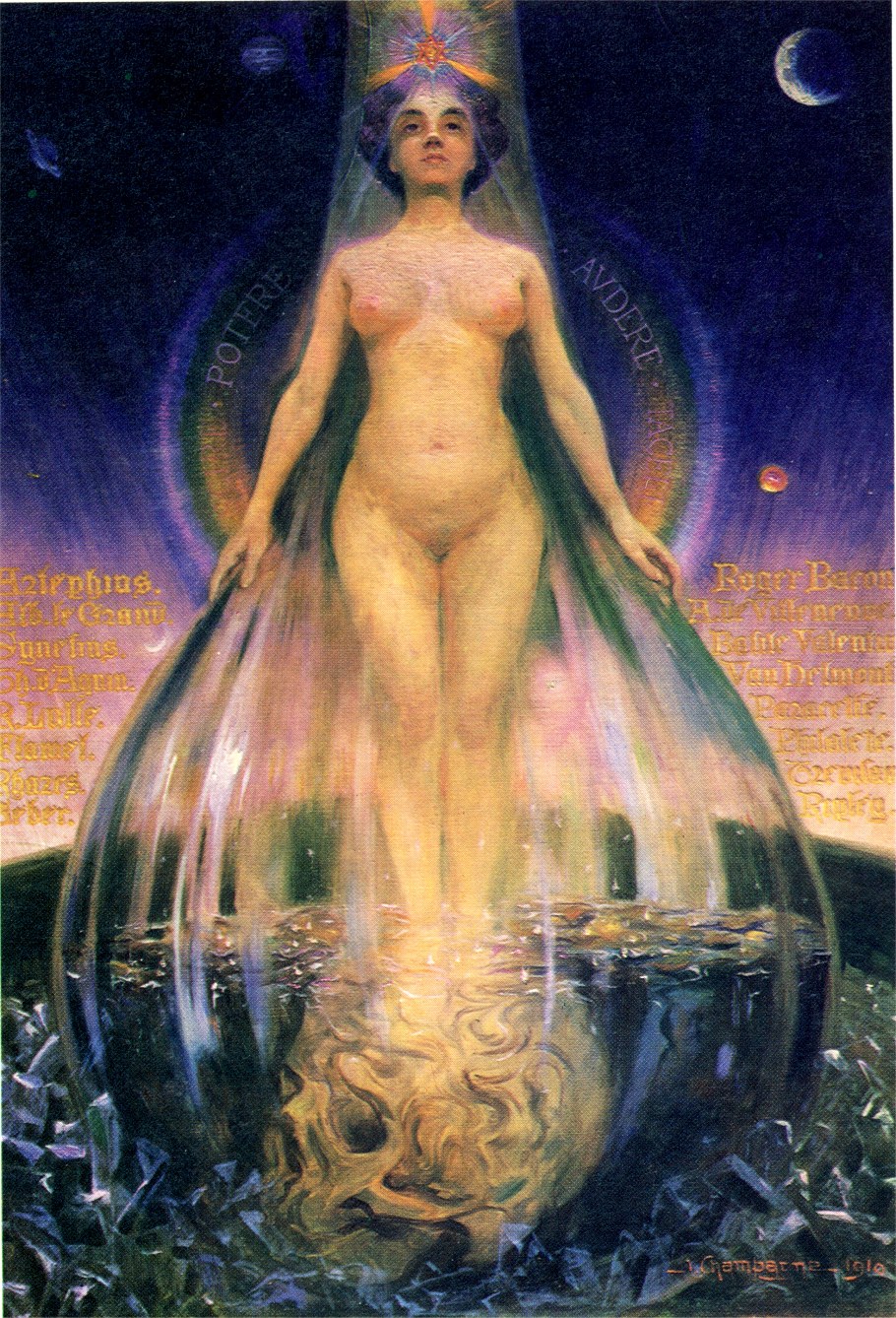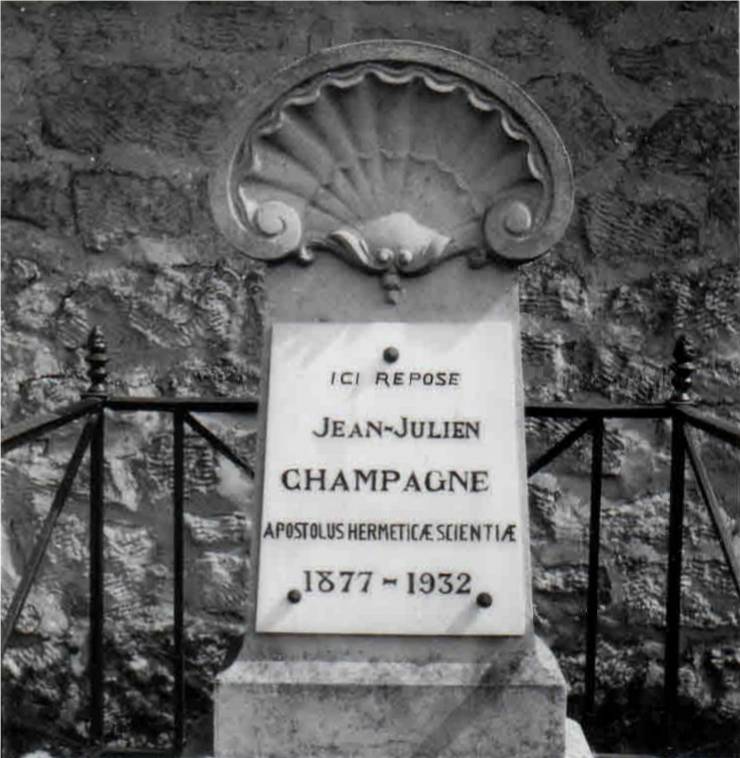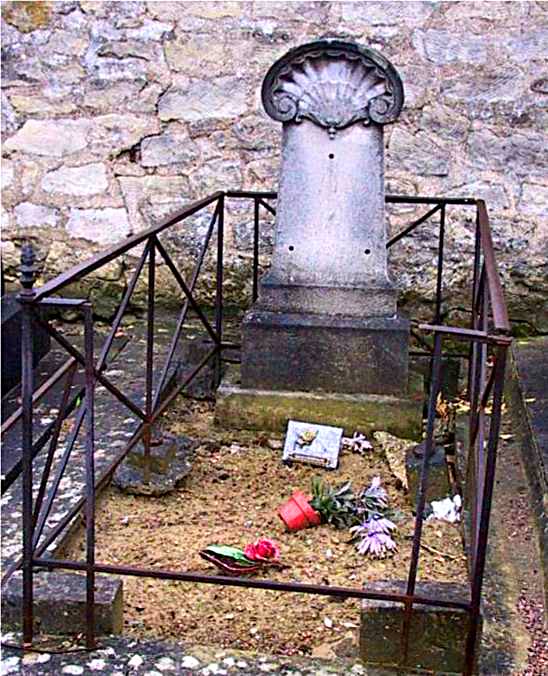|
Fulcanelli (1877-1932)
|

Julien Champagne in His Laboratory ca. 1927 |

Sketch of Fulcanelli made by R. A. Schwaller de Lubicz
in February 1930 |

Self Portrait of Julien Champagne
made in the year 1930 |
Fulcanelli was a
mysterious 20th century French alchemist and hermeticist. He was a confidant of
R. A. Schwaller de Lubicz and
collaborated with him in several alchemical experiments. The name Fulcanelli was
a nom de plume. His true identity has been a topic of much
controversy. However, based on information given to
Andre Vandenbroeck
by Schwaller de Lubicz in 1959-1960, it is my opinion that this man was a
Parisian painter and illustrator named
Julien Champagne
(1877-1932).
True Identity
of Fulcanelli
Schwaller de
Lubicz never specifically identified Fulcanelli by his true name; however, the information he gave to Vandenbroeck
concerning the date and circumstances of Fulcanelli's death in 1932 strongly
indicate that this man was Julien Champagne. Also, a comparison of de
Lubicz's sketch of Fulcanelli with known images of Champagne (see above) confirm
that these men were one and the same. Concerning the sketch de Lubicz made of
Fulcanelli, in February 1930, Vandenbroeck provides the following when
describing the de Lubicz country estate of Lou-Mas-de-Coucagno, located in the
town of Plan-de-Grasse in southeastern France:
The upper stories of the house
could be reached in two ways. ... There was ... a broad staircase rising
directly to the second floor where Isha [de Lubicz's wife] had her quarters and
Dr. Lamy [de Lubicz's stepson] his clinic. ... Mounting these stairs to the
doctor's office, there was a stately wooden balustrade on the right. On
the left, the stairway ran along a wall hung with prints, photographs, and
drawings. One drawing in particular, one drawing alone, I should say, of
all the graphic work that was closely hung there, had attracted my attention
from the very first. It was a pencil sketch of a man in his forties
perhaps, or older, a small intellectual face with delicate features, a high
forehead and deep-set eyes, long sparse hair combed backward and falling
somewhat untidily toward the sides. It was a Gallic physiognomy which
reminded me of photographs I had seen of
Paul Valéry.
The most characteristic feature was the dense, drooping mustache, so typically
French that it is called "a la gauloise." ... I found myself climbing this
staircase in Aor's [de Lubicz's] company. It was the only time I found
myself alone with him in front of this drawing. ... he turned when he felt me
lagging, stopped and saw what I was contemplating: "Its Fulcanelli," he
said. "I did the sketch when he was here."
Al-Kemi A Memoir
by Andre Vandenbroeck, published 1987, pages 138-139.
Le
Vaisseau du Grand Oeuvre
| Julien Champagne's most famous
painting, Le Vaisseau du Grand Oeuvre (Vessel of the Great
Work), was completed in the year 1910. The painting was a great
favorite among the Parisian occultists during the first third of the
20th Century. The voluptuous
model for the painting was purported to be the young female alchemist,
Louise Barbe (ca. 1879-1919); she was the wife of the infamous Russian
"monkey gland" surgeon, Serge Voronoff (1866-1951). Louise was a member of the occult circle
which gathered at the salon of the de Lesseps family (children of the
great
Ferdinand de Lesseps) in Paris.
Of course, the "Great Work" is Alchemy,
and the painting is filled with alchemical symbolism. The nude
female figure is a personification of the philosopher's stone; she
stands within a glass flask and is surrounded by myriad blazing flames.
Off the right shoulder of the young woman is the word "POTERE" meaning
"power" in English; off of her left shoulder is the word "AVDERE"
meaning "to dare" in English. The background on the left and right sides
of the flask contain the names of certain philosophers and alchemists
written in Latin letters.
The names on the left side are as
follows:
Artephius, Albert le Grand, Synesius, Th.
d'Aquin, R. Lulle, Flamel, Rhazes, and Geber.
The names on the right side are as follows: Roger
Bacon, A. de Villeneuve, Basile Valentin, Van Helmont, Paracelse,
Philalethe, Trevisan, and Ripley.
In the darkened sky behind the female
figure are depictions of the Moon and four planets that are visible to the naked eye: above
her right shoulder are Saturn and Jupiter; on her lower right side is a
crescent Venus (Morning Star); above her left shoulder is a crescent
Moon; and to her
lower left is the planet Mars. On her forehead the woman wears a sparkling
diamond of the Queen of Heaven, Isis, the Goddess of magic and the occult arts.
The diamond represents the "Great Eye," which Isis is purported to have
stolen from Ra, the supreme God of Pharaonic Egypt.
Eugène Canseliet used a representation of
this painting as the frontispiece in the 1979 reprint of his book
entitled Deux
logis alchimiques, en marge de la science et de l'histoire
(originally published in 1945). |

Le Vaisseau du Grand Oeuvre by Julien
Champagne (1910) |
Books
Published Under the Name of Fulcanelli
In 1926 and 1930,
respectively, Eugène
Canseliet
(1899-1982), published two books using the pen name of
Fulcanelli. Canseliet stated that these books were based upon detailed notes given to him by Fulcanelli.
They are:
1)
Le Mystère des Cathédrales (The Mystery of the
Cathedrals), first published in 1926; and
2)
Les Demeures Philosophales (Dwellings of the
Philosophers), first published in 1930.
Unpublished Third
Book - Finis Gloriae
Mundi
| Purportedly, Fulcanelli also provided notes to Canseliet
for a
third book tentatively entitled Finis Gloriae Mundi (End
of the Glory of the World) but had the work withdrawn from
publication for unknown reasons. The proposed title of
this book is also the title of a painting preserved at the
Church of San Jorge, Hospital de la Santa Caridad in Séville,
Spain. This work, an oil on wood panel measuring 220 x 216
centimeters, was created by the Spanish artist Juàn de Valdès
Léal in 1672. It is believed that the painting was a favorite of Fulcanelli
hence the proposed book title.
This painting, of the
interior of a crypt, is filled with hermetic symbolism.
The skeleton of a bishop lies within his open coffin;
large black insects crawl over him. Next to the bishop,
the relatively undecomposed corpse of a knight lies
juxta-positioned in his open coffin; the emblem on his
shield suggests an association with the Order of the
Knights Templers. At the top of the painting, the rather
effeminate hand of Christ, bearing the mark of
crucifixion, descends from the clouds carrying a scale.
Presumably the scale represents the role of Christ, like
Osiris before him, in judging the quick and the dead.
The plates of the scale are weighing the lifeworks of
the bishop against the knight; each plate contain a
heart and various other objects associated with each
man. The left-hand plate of the scale is inscribed with
the Latin word nimas (neither more) and the
right-hand plate is inscribed with the word nimenos
(nor less).
On
the left side of the painting, at the entry to the
crypt, an owl (symbol of wisdom to the ancient Egyptians
and Greeks) is perched in a watchful posture, seeming to
"weigh" the situation seriously. To the rear of the
painting, lies another skeleton and several scattered
bones which add to the macabre nature of the scene. |

Finis Gloriae
Mundi by Juàn de Valdès Léal (1672) |
Schwaller de
Lubicz Meets Fulcanelli Schwaller de Lubicz
explained to
Andre Vandenbroeck the
circumstances surrounding his first meetings with Fulcanelli
and why he decided to work with him:
I came in touch with
the man quite naturally, as we were frequenting the same
café,
the Closerie des Lilas, in Montparnasse. This was before
the First World War. ... I never took a liking to Fulcanelli,
but he was the only one in Paris I could talk to about the
Oeuvre [Alchemical Work]. He had a few disciples of
sorts, a fellow named Boucher, I remember, and Eugène Canseliet,
of course, who never left his side. ... He knew what he was
doing, from a practical point of view. He was about ten
years older than I, and rather well connected in the publishing
world, or so he told me. But there were aspects he did not
understand, theoretical aspects, what I call doctrine. ... He
had made a technique of the proper gesture needed in the work,
instead of leaving it to be divinely inspired, but what a
technique! An unbelievable manipulator! This is
valuable, of course, it is what makes the artist, but it does
not make the philosopher. I guess he himself realized to what
degree we complemented each other. He was a very strange
fellow, a prankster, and he lived the Fulcanelli intrigue in all
its details. ... He did not have the symbolique to express
himself. He was still speaking in terms of Basil Valentine
and Flamel or Jabir, but he himself had no specific form.
And that was what I was able to give him.
Ibid., pages 76-77.
Was
Fulcanelli a Plagiarist?
In his 1926 book
entitled Le Mystère des Cathédrales, Fulcanelli provided detailed
analyses of the Notre Dame Cathedrals of Paris, Amiens, Bourges and several
other sites in France. Schwaller de Lubicz told Vandenbroeck that most of
the book was based on a draft manuscript that he had previously loaned to
Fulcanelli. Thus, most of the Fulcanelli book had been plagiarized! Schwaller stated
the following:
I showed him [Fulcanelli]
the documentation I had gathered of cathedral symbolism. He got very
excited and assured me he would give me a hand in publishing it. I was at
that time thinking about moving away from Paris; the whole social affair was
taking too much of my time. But I had been working on a book with detailed
proof through the structural elements of the cathedrals, and through the
sculpture and ornaments, that they were a Christian expression of the Hermetic
Oeuvre. ... I did talk to him about all the material I had gathered concerning
the symbolism of cathedrals. At that time I intended to publish something
on the subject, and he made me believe he could help me; he had connections.
He really was most interested when I showed him the manuscript, and asked to
borrow it for a few days, to look at it more closely in view of presenting it to
a publisher. It took me a long time to get the manuscript back, and when
he did return it, his opinion was that this material should not get published,
that it revealed too much, and publication was bound to lead me to adverse
consequences. A regular confidence man he was, that one! But I admit
I had had thoughts in that direction myself, and he merely confirmed them.
Well I had other things on my mind. I was at that time preparing to move
up to Suhalia [in Switzerland], and that was an enormous undertaking. We
left shortly thereafter and I gave no further thought to the matter. I
didn't stay in touch with the Paris people, wanted to get away from all that
social involvement. Then in 1926 I find out about the publication of Le Mystère des Cathédrales!
It was completely based on my work.
Ibid., pages 80-81.
Death of
Fulcanelli
According to Schwaller de Lubicz,
the man known as Fulcanelli died in 1932. Several months before his death,
Fulcanelli had indicated his desire to tell the world about the successful
alchemical experiments that had been conducted at the de Lubicz estate in
Plan-de-Grasse in 1930. Schwaller was strongly against this course of
action and, was initially able to dissuade Fulcanelli. However, several
weeks later, the already ailing Fulcanelli sent a him a note saying that he had
scheduled a meeting with several adept friends to tell them of the experiment.
Upon receipt of this note,
De Lubicz immediately left for Paris and visited Fulcanelli at his lodgings; it
turned out to be on the day before he died. In his book, Vandenbroeck
writes that de Lubicz told him the following:
"He [Fulcanelli] was already sick when he
came here last time, limping somewhat and complaining of circulatory problems.
And he persisted in this insane desire to come forth with whatever he thought he
had understood. I reminded him again of his vow of secrecy and warned him
that no good could come from breaking it. It was useless. Six weeks
later he wrote me a line announcing a meeting he had scheduled for a limited
group of adept friends: he was going to talk about our experiment." ...
He [de Lubicz] had gone to Paris a few
days before the scheduled event, had gone straight up to Fulcanelli's mansarde
and been aghast at what he found. Fulcanelli was deathly ill.
Gangrene had set in on his leg, and his complexion was dark gray.
"He was turning black," Aor said almost
inaudibly, all harmonics gone from the timbre of his voice, "and he could barely
speak. Imagine he could no longer speak! We looked at each other for
a long while, and then he shook his head. I think he understood. He
pointed to a pile of papers on a bookshelf and had me look through them. I
found the six pages of manuscript he had stolen and that we had been working
with, the manuscript, I am convinced, that had brought us both to this
moment. He made me understand that he wanted me to have it, and that no
copy existed. I put it in my pocket and left. He was dead the next
morning."
Ibid., page 232.
Burial Site of Fulcanelli
| Julien Champagne, alias
Fulcanelli, died on 26 August 1932. He was buried in the cemetery
at Arnouville-les-Gonesse, a northern suburb of Paris; Schwaller de
Lubicz paid to have a tombstone placed over the gravesite with the
following inscription:
ICI REPOSE
JEAN-JULIEN
CHAMPAGNE
APOSTOLUS HERMETICAE
SCIENTIAE
1877-1932
|

Tombstone of Julien Champagne |

Gravesite of Julien Champagne |

|






